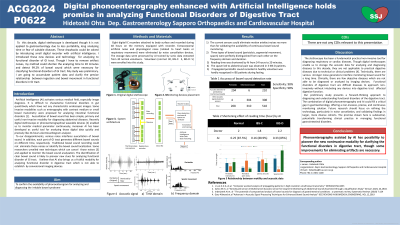Sunday Poster Session
Category: Functional Bowel Disease
P0622 - Digital Phonoenterography Enhanced With Artificial Intelligence Holds Promise in Analyzing Gastrointestinal Functional Disorders
Sunday, October 27, 2024
3:30 PM - 7:00 PM ET
Location: Exhibit Hall E

Has Audio
.jpg)
Hidetoshi Ohta, PhD
Sapporo Orthopaedics and Cardiovascular Hospital
Sapporo, Hokkaido, Japan
Presenting Author(s)
Hidetoshi Ohta, PhD
Sapporo Orthopaedics and Cardiovascular Hospital, Sapporo, Hokkaido, Japan
Introduction: Artificial Intelligence (AI) activates various medical field, especially image diagnosis. It is difficult to characterize functional disorders in gut quantitively which have not any characteristic endoscopic images. Some invasive modalities such as enterography with contrast medium or small bowel manometry were proposed for analyzing intestinal functional disorders [1]. Auscultation of bowel sound has been simple, primary and useful non-invasive modality for diagnosing abdominal diseases. Recently digital stethoscope or phonoenterographical wearable devices [2] enabled us to monitor medical parameter continuously, moreover AI has been developed as useful tool for analyzing those digital data quickly and precisely like 24-hours electrocardiogram analyzer.
Methods: Eight digital voice recorders attached to body surface and recorded during 48 hours on the memory equipped with recorder. Extracorporeal artificial noise and physiological noise (related to heart beats or respiratory movement) were eliminated by noise cancellation devices. The storage data were processed by AI trained by sonic data extracted from 30 normal volunteers. Volunteers (normal: 30, irritable bowel syndrome [IBS]: 5) were enrolled into this study.<br><br>
Results: 1) The current sensors could eliminate motion artefact noises no more than for validating the availability of continuous bowel sound monitoring. 2) Three types of bowel sound (peristalsis, segmental movement, spasm) were perfectly distinguished from each other on the frequency domain and duration. 3) The spasm led to abdominal pain was observed in 3 of 5 IBS patients. 4)Propagated peristaltic sound recorded in healthy volunteer was hardly recognized in IBS patients during fating.
Discussion: Phonoenterography with AI has possibility to pioneer the new noninvasive modality for clarifying the functional disorders in digestive tract, though some improvements for eliminating artefacts are necessary.
Reference: [1] Luis G A G, et.al. “Computer assisted analysis of propagating patterns in high resolution small bowel manometry” DDW2024 Mo1633 [2] Zahra M et. al “SonicGuard sensor-A Multichannel Acoustic sensor for long term Monitoring of Abdominal Sounds Examined through a Qualification Study” Sensors 2024, 24,1843.
Disclosures:
Hidetoshi Ohta, PhD. P0622 - Digital Phonoenterography Enhanced With Artificial Intelligence Holds Promise in Analyzing Gastrointestinal Functional Disorders, ACG 2024 Annual Scientific Meeting Abstracts. Philadelphia, PA: American College of Gastroenterology.
Sapporo Orthopaedics and Cardiovascular Hospital, Sapporo, Hokkaido, Japan
Introduction: Artificial Intelligence (AI) activates various medical field, especially image diagnosis. It is difficult to characterize functional disorders in gut quantitively which have not any characteristic endoscopic images. Some invasive modalities such as enterography with contrast medium or small bowel manometry were proposed for analyzing intestinal functional disorders [1]. Auscultation of bowel sound has been simple, primary and useful non-invasive modality for diagnosing abdominal diseases. Recently digital stethoscope or phonoenterographical wearable devices [2] enabled us to monitor medical parameter continuously, moreover AI has been developed as useful tool for analyzing those digital data quickly and precisely like 24-hours electrocardiogram analyzer.
Methods: Eight digital voice recorders attached to body surface and recorded during 48 hours on the memory equipped with recorder. Extracorporeal artificial noise and physiological noise (related to heart beats or respiratory movement) were eliminated by noise cancellation devices. The storage data were processed by AI trained by sonic data extracted from 30 normal volunteers. Volunteers (normal: 30, irritable bowel syndrome [IBS]: 5) were enrolled into this study.<br><br>
Results: 1) The current sensors could eliminate motion artefact noises no more than for validating the availability of continuous bowel sound monitoring. 2) Three types of bowel sound (peristalsis, segmental movement, spasm) were perfectly distinguished from each other on the frequency domain and duration. 3) The spasm led to abdominal pain was observed in 3 of 5 IBS patients. 4)Propagated peristaltic sound recorded in healthy volunteer was hardly recognized in IBS patients during fating.
Discussion: Phonoenterography with AI has possibility to pioneer the new noninvasive modality for clarifying the functional disorders in digestive tract, though some improvements for eliminating artefacts are necessary.
Reference: [1] Luis G A G, et.al. “Computer assisted analysis of propagating patterns in high resolution small bowel manometry” DDW2024 Mo1633 [2] Zahra M et. al “SonicGuard sensor-A Multichannel Acoustic sensor for long term Monitoring of Abdominal Sounds Examined through a Qualification Study” Sensors 2024, 24,1843.
Disclosures:
Hidetoshi Ohta indicated no relevant financial relationships.
Hidetoshi Ohta, PhD. P0622 - Digital Phonoenterography Enhanced With Artificial Intelligence Holds Promise in Analyzing Gastrointestinal Functional Disorders, ACG 2024 Annual Scientific Meeting Abstracts. Philadelphia, PA: American College of Gastroenterology.

